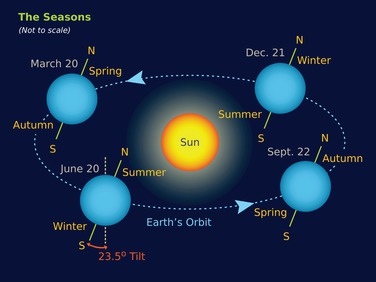The Seasons
The Four Seasons
So now it all falls into place: The seasons occur because the Earth is tilted as it moves through its yearly orbit around the sun.
At the solstice on June 21 or 22, Earth's Northern Hemisphere is at its maximum tilt toward the sun. The sun's rays hit the Earth most directly, heating the surface more and for a longer time.
At the same time the Southern Hemisphere is at its furthest tilt away from the sun, and the effect of the sun's light is not as intense.
The situation is reversed at the other solstice on December 21. Light rays hit Earth at a shallower angle in the Northern Hemisphere and don't heat up the surface as much.
The midway points—the equinoxes—define spring and autumn.
